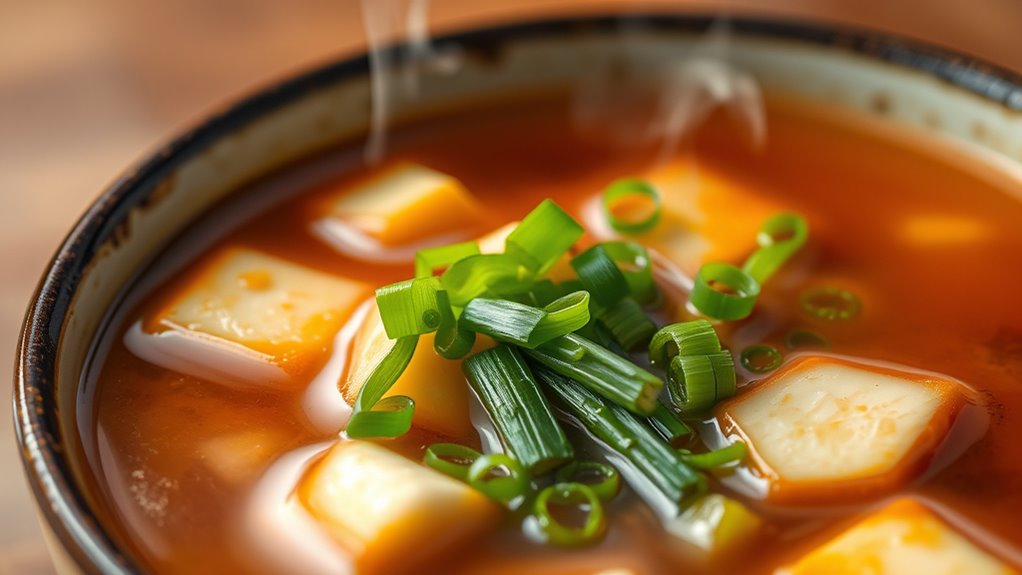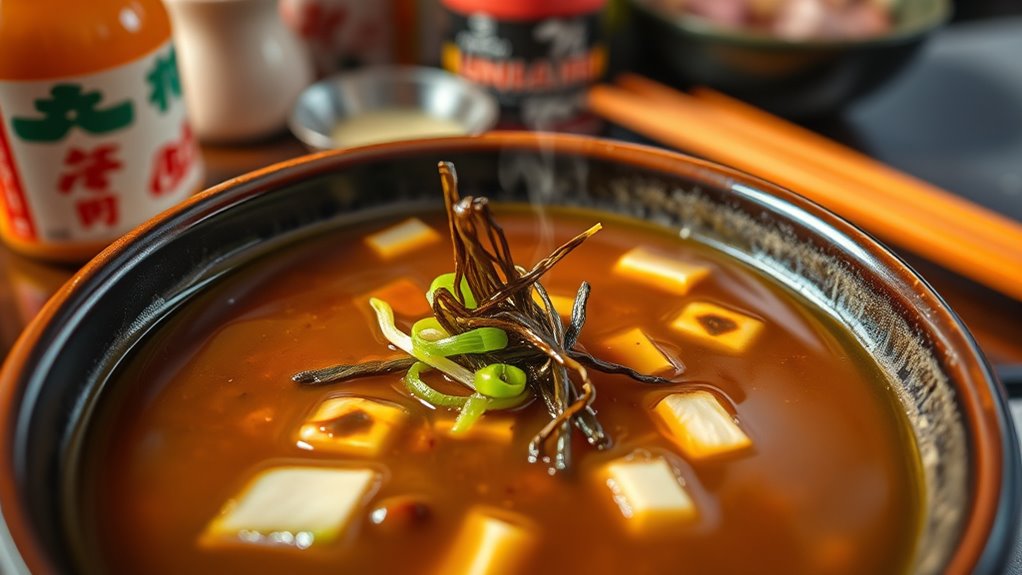Umami is the fifth essential taste that adds savory richness and depth to dishes worldwide. It’s recognized for amplifying flavors and making food more satisfying and enjoyable. From soy sauce and mushrooms to aged cheeses, umami enhances and balances other tastes like sweetness and acidity. Its global appeal lies in its ability to create complex, comforting flavors that boost appetite and satisfaction. If you keep exploring, you’ll discover how this taste influences cuisine across cultures and cuisines.
Key Takeaways
- Umami is recognized as the fifth fundamental taste, adding depth and savoriness to global cuisines.
- It is detected through specific receptors responding to amino acids like glutamate found in various ingredients.
- Different cultures, such as Japan and Italy, value umami-rich foods like kombu, mushrooms, aged cheese, and cured meats.
- Umami enhances overall flavor, increases appetite, and promotes satisfying, layered dining experiences worldwide.
- Scientific research highlights umami’s role in flavor perception, nutrition, and its ability to make dishes more addictive and enjoyable.

Many people are surprised to learn that umami is recognized as the fifth fundamental taste, alongside sweet, sour, salty, and bitter. Unlike the other tastes, umami isn’t as widely understood or discussed, but it plays a vital role in how you perceive flavor. It’s often described as a savory or meaty taste that adds depth and richness to dishes. When you taste a perfectly cooked steak, aged cheese, or a bowl of miso soup, you’re experiencing umami. It’s subtle yet powerful, enhancing the overall flavor profile and making foods more satisfying.
You might notice that umami isn’t as immediately obvious as salty or sweet, but it’s just as important in creating complex, well-rounded flavors. It’s primarily detected through specific receptors on your tongue that respond to amino acids like glutamate, which naturally occur in many foods. These amino acids act as flavor enhancers, intensifying the taste experience. That’s why adding ingredients like soy sauce, mushrooms, or Parmesan cheese can transform a simple dish into something more layered and fulfilling.
Umami doesn’t just add flavor; it amplifies other tastes, balancing sweetness and acidity and smoothing out bitterness. Many cultures around the world have long appreciated umami’s effects, even if they didn’t recognize it as a distinct taste. In Japan, for example, umami has been an integral part of traditional cuisine for centuries, with ingredients like kombu seaweed and fermented soy products playing starring roles. In Italy, aged cheeses and cured meats have been valued for their savory qualities.
This global appeal comes from umami’s ability to make food more addictive and satisfying, encouraging you to keep eating and enjoying each bite. Chefs and home cooks alike harness umami to create dishes that feel deeply layered, rich, and comforting. You might also find yourself craving foods high in umami because it triggers a pleasurable response in your brain, similar to other fundamental tastes. It can boost your appetite and improve satiety, making meals more enjoyable and fulfilling.
As food science continues to explore umami, researchers recognize its importance not just for flavor but for overall health and nutrition. This taste helps you appreciate the complexity of what you eat and encourages a more mindful approach to cooking and eating. Whether you realize it or not, umami influences your food choices and enhances your dining experience, making it an essential part of global cuisine.
Frequently Asked Questions
How Does Umami Differ From Sweet, Sour, Salty, and Bitter Tastes?
When you compare umami to sweet, sour, salty, and bitter tastes, you’ll notice it offers a savory, rich flavor that enhances dishes rather than standing out on its own.
Unlike sweet or bitter, umami results from specific amino acids like glutamate, giving foods a depth that balances flavors.
You experience umami in foods like mushrooms, aged cheese, and soy sauce, adding a satisfying, mouth-filling sensation to your meals.
Are There Health Benefits Associated With Consuming Umami-Rich Foods?
Imagine your taste buds as a symphony, with umami adding a rich, savory note that balances the melody.
Consuming umami-rich foods can boost your health by reducing the need for excess salt, helping manage blood pressure. They also promote satiety, potentially aiding weight control, and supply beneficial amino acids.
Embracing these flavors can enhance your meals while supporting your well-being, making your dining experience both delicious and nourishing.
Which Cultures Traditionally Emphasize Umami in Their Cuisine?
You’ll find that many Asian cultures, especially Japanese, Chinese, and Korean cuisines, traditionally emphasize umami. They use ingredients like soy sauce, miso, and dried mushrooms to enhance flavors. Italian cuisine also highlights umami, with ingredients like aged cheeses and tomatoes. By incorporating these foods, these cultures create rich, savory dishes that highlight the importance of umami, making their cuisine deeply satisfying and memorable.
Can Umami Be Artificially Replicated or Enhanced in Foods?
Think of umami as a secret ingredient that can be painted onto foods with a brush of science. You can artificially replicate or enhance it using additives like monosodium glutamate (MSG) or natural sources like aged cheeses and fermented products. These methods act like a maestro’s baton, amplifying savory flavors and making dishes more profound.
How Does Umami Influence Appetite and Food Preference?
You notice that umami can boost your appetite because it enhances the savory flavors you enjoy. When foods contain umami, you often find them more satisfying and tend to prefer them over others.
This taste influences your food choices by making certain dishes more appealing, encouraging you to eat more or seek out similar flavors. Overall, umami plays a key role in shaping your cravings and food preferences.
Conclusion
Now that you understand umami’s unique flavor, you can appreciate its power to enhance dishes, deepen flavors, and bring people together. You see how it’s more than just a taste—it’s an experience, a connection, a celebration of culinary diversity. As you explore new cuisines, embrace umami’s richness, savor its complexity, and share its magic with others. Because in every savory bite, umami invites you to discover, indulge, and enjoy life’s flavorful moments.









